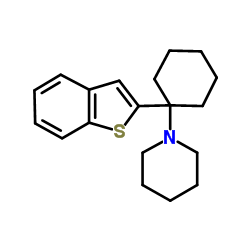Synthesis and biodistribution of two potential PET radioligands for dopamine reuptake sites: no-carrier-added 4-(2-[18F]fluoroethyl) and 4-[11C]methyl BTCP-piperazine.
I Loustau-Then, M Ponchant, C Fuseau, J M Kamenka, J Vignon, C Crouzel
Index: Nucl. Med. Biol. 24(6) , 513-8, (1997)
Full Text: HTML
Abstract
Radioligands that specifically target dopamine uptake sites can provide a means of determining dopamine fiber loss at intrastriatal mesencephalic grafts in Parkinsonian patients, using Positron Emission Tomography (PET). The BTCP derivative, 1-[1-(2-benzo(b)thiophenyl)cyclohexyl]-4-(2-hydroxyethyl)-piperazine, shows in vitro high affinity and selectivity for the dopamine transporter. To evaluate the potential of such a compound as a potential dopaminergic PET tracer the positron-emitting analogues, 1-[1-(2-benzo(b)thiophenyl)cyclohexyl]-4-(2-[18F]fluoroethyl)-piperazine and 1-[1-(2-benzo(b)thiophenyl)cyclohexyl]-4-[11C]methylpiperazine, were synthesized. Radiofluorination was carried out by the reaction of 1-[1-(2-benzo(b)thiophenyl)cyclohexyl]-4-(2-chloroethyl)-piperazine with cyclotron-produced n.c.a. 18F-(half life 109.9 min) obtained by the (p,n) reaction on 18O-enriched water. Labelling with carbon-11 (half life 20.4 min) was achieved by 11C methylation of 1-[1-(2-benzo(b)thiophenyl)cyclohexyl]-piperazine with [11C]methyl iodide. After intravenous administration to rats these two compounds enter the brain, but despite their high in vitro affinity they display a high non specific binding in vivo which greatly limits their use as PET radioligands.
Related Compounds
| Structure | Name/CAS No. | Molecular Formula | Articles |
|---|---|---|---|
 |
BTCP HCl
CAS:112726-66-6 |
C19H25NS |
|
Studies of the biogenic amine transporters. III. Demonstrati...
1994-03-01 [J. Pharmacol. Exp. Ther. 268 , 1462-1475, (1994)] |
|
Developmentally regulated glycosylation of dopamine transpor...
1994-11-18 [Brain Res. Dev. Brain Res. 83(1) , 53-8, (1994)] |
|
MK-801, phencyclidine (PCP), and PCP-like drugs increase bur...
1993-02-01 [Synapse 13(2) , 108-16, (1993)] |
|
N-[1-(2-benzo[b]thiophenyl)Cyclohexyl]- piperidine (BTCP) ex...
2000-09-01 [Biol. Psychiatry 23(3) , 316-25, (2000)] |
|
Thermodynamics of the binding of BTCP (GK 13) and related de...
1994-08-16 [Eur. J. Pharmacol. 268(3) , 357-63, (1994)] |